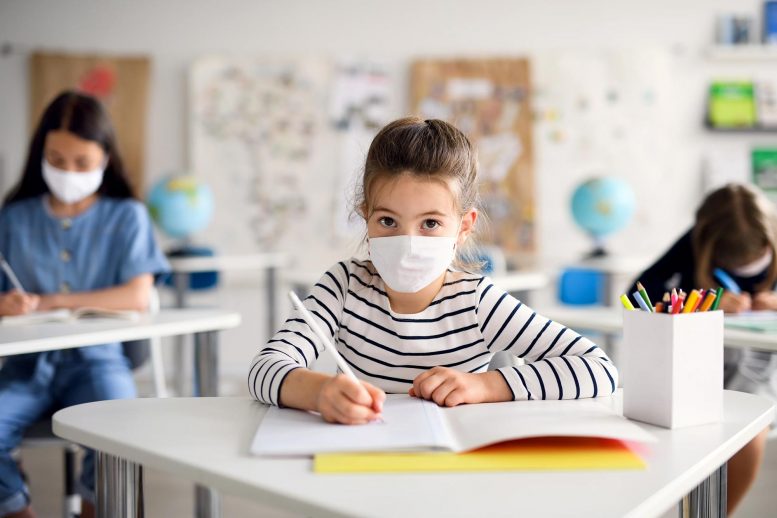
No substantial difference in COVID-19 cases was found between students or staff in school districts implementing a three-feet versus six-feet distancing policy, according to researchers.
Massachusetts statewide study showed no significant differences in COVID-19 case rates between K-12 districts that implemented 3-feet versus 6-feet of physical distancing.
As COVID-19 infection rates continue to fall, Massachusetts officials are signaling it’s almost time to end remote learning and send all school-aged children back to the classroom. While emerging data suggest young children and schools have not been primary drivers of the COVID-19 pandemic, evidence to guide best practices to prevent the spread of the virus in the school setting has been limited and, as a result, national and international recommendations are inconsistent.
A study led by Beth Israel Deaconess Medical Center (BIDMC) physician-researchers provides new, much-needed data about the optimal physical distancing between students for the prevention of COVID-19 in the school setting. In a retrospective, statewide cohort study, the researchers compared the rates of COVID-19 cases in students and staff in Massachusetts public schools among districts with universal mask mandates but different physical distancing requirements. The team found no substantial difference in the number of cases of COVID-19 among either students or staff in school districts that implemented a distancing policy of three feet versus six feet between students. The findings, published in the journal Clinical Infectious Diseases, suggest that lower physical distancing policies can be adopted in school settings with masking mandates without negatively impacting student or staff safety.
“Prior studies have not directly compared the impact of different physical distancing policies among students attending in-person school,” said lead author Polly van den Berg, MD, a fellow in the Division of Infectious Diseases at BIDMC. “This research, which found no substantial difference in the number of cases among either students or staff in school districts that implemented a distancing policy of three versus six feet between students, is important because many school buildings have physical infrastructure that cannot accommodate six feet of distancing and bring all (or most) students back into the classroom.”
Van den Berg and colleagues looked at publicly available data from 251 Massachusetts school districts, encompassing 537,336 students and 99,390 staff who attended in-person instruction during a 16-week study period from September 2020 to January 2021. Using a combination of information – including individual district infection control plans, the number of infections reported to the Commonwealth by districts, and community rates of COVID-19 from a non-partisan, not-for-profit data dashboard – the scientists found no significant difference in the rate of COVID-19 cases among students and staff in districts that mandated six feet of distancing versus in districts that mandated three feet of distancing. The scientists note that physical distancing was only one of several infection prevention measures taken by school districts.
“These data can be used to inform and update how infection control plans are implemented in school settings,” added corresponding author Westyn Branch-Elliman, MD, MMSc, an infectious disease specialist at BIDMC and a clinical investigator at VA Boston Healthcare System. “It is important to remember that distancing was just one of a number of interventions adopted in the districts included in our analysis. Across the districts included in our study, there was a near-universal masking mandate, thus our study addresses the question of the effectiveness of three versus six feet of distancing among students and staff who are wearing masks.”
The team’s findings also showed that, in general, schools had lower overall rates of infection than their surrounding communities, lending support to the idea that in-person learning is not a major driver of the pandemic; however, district case rates were tightly linked to those of the community, particularly among staff.
“Early in the pandemic, infection control plans for schools and other settings were developed based on the best available evidence at the time — which, early on, was limited,” said Branch-Elliman, also an Assistant Professor of Medicine at Harvard Medical School. “We hope that our findings can be used to update current recommendations about distancing policy, and ultimately, to help return more students to the classroom.”
Reference: “Effectiveness of 3 Versus 6 ft of Physical Distancing for Controlling Spread of Coronavirus Disease 2019 Among Primary and Secondary Students and Staff: A Retrospective, Statewide Cohort Study” by Polly van den Berg, Elissa M Schechter-Perkins, Rebecca S Jack, Isabella Epshtein, Richard Nelson, Emily Oster and Westyn Branch-Elliman, 10 March 2021, Clinical Infectious Diseases.
DOI: 10.1093/cid/ciab230
Co-authors include Elissa M. Schechter-Perkins, MD, MPH, of Boston University School of Medicine and Boston Medical Center; Rebecca S. Jack, MPP of COVID-19 School Response Dashboard; Isabella Epshtein, MPP, of VA Boston Center for Healthcare Organization and Implementation Research; Richard Nelson, PhD, Veterans Affairs Salt Lake City Healthcare System and University of Utah School of Medicine; and Emily Oster, PhD, of COVID-19 School Response Dashboard and Brown University Watson Institute for International and Public Affairs.
The authors received no financial support for the research, authorship, and/or publication of this article. WBE is the site PI for a grant funded by Gilead pharmaceuticals (funds to institution). EO and RJ are affiliated with the COVID-19 School Dashboard, which is funded in part by the Chan Zuckerberg Foundation and the Arnold Foundation. All other authors have no conflicts to report.









The reason for this is quite simply that masks are ineffective at stopping the spread of a virus, no matter how far people wearing them are from one another. There are, as a science website like this must know, are overwhelming number of studies (the most recent one from Denmark) which show facemasks are about as effective at keeping out a virus as a tennis racquet would be for repelling sand thrown in somebody’s face. Please can we start all following the science, rather than dumbly swallowing misleading political and corporate propaganda pumped out by the captive mainstream media.
That’s great way to stay away of covid-19 spreading out. We should work together against the spreading novel coronavirus. We should follow all of health concern guidelines. You could visit this https://boobs.house/ website and we should perform our activities in online basis. Thanks for sharing this post with us.
Thanks for sharing. we should be careful